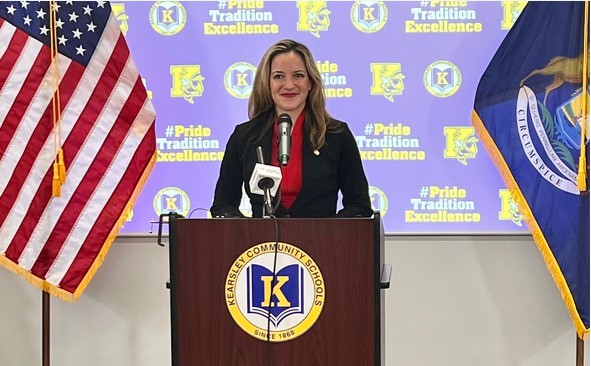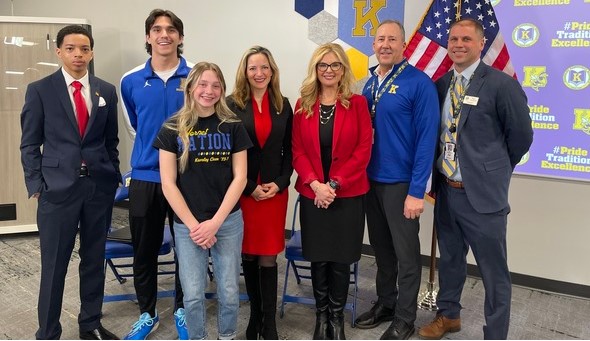Featured photo: Participants at today’s news conference from L to R: Julian Morris, Saginaw High School student; Lucas Groulx, Kearsley High School student; Josie Juniga, Kearsley High School student; Secretary Benson; MEA President Chandra Madafferi; Andy Nester, Kearsley High School driver’s education instructor; Kearsley Community Schools Superintendent Paul Gaudard.
FLINT, Mich. – On Jan. 29, Secretary of State Jocelyn Benson joined educators at Kearsley High School, one of just 38 Michigan schools that provide driver’s education, to call for improved access to driver’s education for high school students across the state and support for public schools looking to provide driver’s training.
Secretary Benson and Michigan Education Association President Chandra Madafferi announced they are working to remove barriers to driver’s education through two voluntary grant programs:
- A need-based grant to cover the costs of Graduated Driver License (GDL) Segments 1 & 2 and road testing.
- A voluntary grant program for public schools, particularly those in underserved geographic areas, to offset expenses associated with becoming a driver’s education provider, including vehicle purchases and hiring instructors.
“Twenty years ago, the state of Michigan shifted the cost burden for driver’s education directly onto teens and their families,”Benson said. “Most private providers deliver quality instruction, but with the first segment of driver’s ed costing as much as $650, many families simply can’t afford it. As a result, fewer teens are getting trained and licensed – especially those who are Black, Hispanic or from low-income families. This year, we will work with educators and partners in state government to help more families afford driver’s education and connect public schools with resources to offer programs for high school students.”

In 2004, the State of Michigan eliminated the Driver Education Fund, putting an end to most school-based driver’s education programs. An analysis of Department of State records shows that in 2000, 66% of eligible Michigan teens had driver’s licenses. By 2021, that number had dropped to 56%.
The move to private instruction has contributed to racial and income inequities. A 2012 nationwide study by the AAA Foundation for Traffic Safety, reported that only 29% of Hispanic teens and 37% of non-Hispanic Black teens had their driver’s licenses by the age of 18, compared to 67% of non-Hispanic white teens. The same study found that only one in four teens in households with total incomes under $20,000 a year had their driver’s licenses before their 18th birthday. But where household income exceeded $100,000, 79% of teens were licensed by the time they turned 18.
“Schools are an ideal place to provide driver’s education – we know our students, we provide exceptional instruction, and are accountable to state standards,” said MEA President Chandra Madafferi, a veteran teacher from Oakland County.
Madafferi added: “Overwhelmingly, Michigan educators and administrators I’ve spoken to want to see driver’s education return to the schools as much as possible. I’m looking forward to working with Secretary Benson and lawmakers to implement programs that shift the cost burden away from families and eliminate some of the inequities keeping Michigan students out of the driver’s seat.”
“Kearsley Community Schools’ comprehensive driver’s education program is an important public service that helps our students learn the skills, knowledge and attitude needed for safe driving,’ said Andy Nester, a driver’s education instructor at Kearsley High School.
Nester added: “Our students are taught by experienced, qualified teachers they know and trust in their familiar school environment. My experience tells me that investing in public school driver’s education programs is an investment in safety and responsible behavior.”
“I recently embarked on the exciting journey of getting my driver’s license only to be confronted by the substantial financial burden that comes with driver’s education,” said Julian Morris, a junior at Saginaw High School.
Morris added: “It’s an issue that not only affects me but affects teenagers all across the state. I recall sharing my experience with some of my peers only to hear ‘at least you can afford to learn to drive.’ Learning to drive should not be determined by affordability. It is a rite of passage and a fundamental step towards independence and responsibility. It opens the doors to education, employment and essential life experience. Driving should not be a privilege reserved only for those who can afford it – access to driver’s training ensures opportunities for teenagers regardless of their economic background.”
The Michigan Department of State (MDOS) currently oversees 281 active driver’s education providers, 38 of which are educational institutions. In 2023, just two of the school-based sites had a complaint or potential violation MDOS had to investigate, compared to 30 private driving schools that had violations. Secretary Benson shared that when there are complaints or violations at school-based sites, they are less severe and are resolved more quickly once identified.


